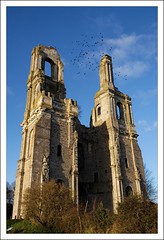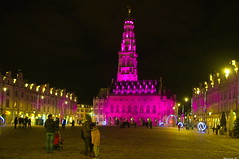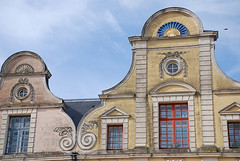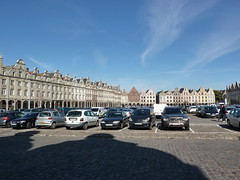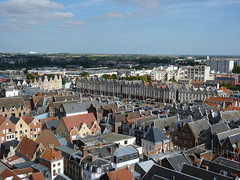Arras
Arras (English: /ˈəs/ , French: [aʁɑs]; ; historical Dutch: Atrecht Dutch: [ˈaːtrɛxt]) is the prefecture of the Pas-de-Calais department, which forms part of the region of Hauts-de-France; before the reorganization of 2014 it was in Nord-Pas-de-Calais. The historic centre of the Artois region, with a Baroque town square, Arras is in northern France at the confluence of the rivers Scarpe and Crinchon.
The Arras plain is on a large chalk plateau bordered on the north by the Marqueffles fault, on the southwest by the Artois and Ternois hills, and on the south by the slopes of Beaufort-Blavincourt. On the east it is connected to the Scarpe valley.
Established during the Iron Age by the Gauls, the town of Arras was first known as Nemetocenna, which is believed to have originated from the Celtic word nemeton, meaning 'sacred space.'
Saint Vedast (or St. Vaast) was the first Catholic bishop in the year 499 and tried to eliminate paganism among the Franks. By 843, Arras was seat of the County of Artois which became part of the Royal domain in 1191.
The first mention of the name Arras appeared in the 12th century. Some hypothesize it is a contraction of Atrebates, a Belgic tribe of Gaul and Britain that used to inhabit the area. The name Atrebates could have successively evolved to become Atrades, Atradis, Aras and finally Arras. Others believe it comes from the Celtic word Ar, meaning 'running water', as the Scarpe river flows through Arras or simply the name of Abraham's wife Sarra spelled backwards.
Arras is Pas-de-Calais' third most populous town after Calais and Boulogne-sur-Mer. The town counted 43,693 residents in 2012, with the Arras metropolitan area having a population of 124,200. Arras is located north of Paris and can be reached in 2 hours by car and in 50 minutes by TGV. It is the historic center of the former Artois province. Its local speech is characterized as a patois. The city of Arras is well known for its architecture, culture, and history. It was once part of the Spanish Netherlands, a portion of the Low Countries controlled by Spain from 1556 to 1714. Louis XIII reconquered Arras in 1640; the town officially became part of France in 1659.
Arras attracts thousands of visitors every year, who commonly explore the city's architecture and historic buildings. Some attractions include the Town Hall and its Belfry (listed as a UNESCO World Heritage Site since 15 July 2005), the "Boves" (a maze beneath the city), the Squares (La Place des Héros and La Grand'Place), the Art District (the Theatre of Arras and the Hôtel de Guînes), the Abbey District (The Saint-Vaast Abbey and the Cathedral of Arras), the Vauban Citadel, and the Nemetacum site (the ancient town founded by the Romans 2000 years ago). The Canadian National Vimy Memorial is just outside the town.
History
Prehistory
Archaeologists found evidence of prehistoric human settlements in the Scarpe basin. The archaeological sites of Mont-Saint-Vaast in Arras and Biache-Saint-Vaast were Stone Age settlements of the Mousterian culture. They were evidenced by the finds of stone tools. These tools show signs of the Levallois technique, a name given by archaeologists to a distinctive type of stone knapping, developed by forerunners to modern humans during the Paleolithic period 170,000 years ago.
Very little was found to document the Bronze Age and Early Iron Age in the Arras area.
Antiquity/Foundation
Arras was founded on the boat of Baudimont by the Belgic tribe of the Atrebates, who named it Nemetocenna in reference to a nemeton that probably existed there. It was later renamed Nemetacum/Atrebatum by the Romans, under whom it became an important garrison town.
In the Scarpe valley, archaeologists' excavations and data recovery revealed Late Iron Age settlements. These buildings, believed to be farms, were found near the municipalities of Arras, Hamblain-les-Prés and Saint-Pol.
Medieval and early modern period
Before the Middle Ages
In the 4th century, Nemetacum was renowned for its arts and crafts as well as textiles trade throughout the whole empire. Between 406 and 407, the city was taken and destroyed by Germanic invaders. In 428, the Salian Franks led by Clodion le Chevelu took control of the region including the current Somme department. Roman General Aetius then chose to negotiate for peace and concluded a treaty (fœdus) with Clodion that gave the Franks the status of «foederati» fighting for Rome.
The town's people were converted to Christianity in the late 4th century by Saint Innocent, who was killed in 410 during a barbarian attack on the town. In 499, after the conversion of Clovis I to Catholicism, a diocese (évêché in French) was created in Arras, the Roman Catholic Diocese of Arras, and given to Saint Vaast (also known as Saint Vedast in English), who remains the diocesan patron saint. Saint Vaast then established an episcopal see and a monastic community. It was suppressed in 580 to found the Roman Catholic Diocese of Cambrai, from which it would reemerge five centuries later.
Early Middle Ages
In 667 Saint Aubert, bishop of Cambrai, decided to found the Abbey of Saint Vaast, which developed during the Carolingian period into an immensely wealthy Benedictine abbey. The modern town of Arras initially spread around the abbey as a grain market. During the 9th century, both town and abbey suffered from the attacks of the Vikings, who later settled to the west in Normandy. The abbey revived its strength in the 11th century and played an important role in the development of medieval painting, successfully synthesizing the artistic styles of Carolingian, Ottonian and English art.
High Middle Ages
In 1025, a Catholic council was held at Arras against certain Manichaean (dualistic) heretics who rejected the sacraments of the Church. In 1093, the bishopric of Arras was refounded on territory split from the Diocese of Cambrai. In 1097 two councils, presided over by Lambert d'Arras, dealt with questions concerning monasteries and persons consecrated to God. In this time, Arras became an important cultural center, especially for the group of poets who came to be known as trouvères. One particular society of such poets was later called the Puy d'Arras.
The wool industry and trade
The town was granted a commercial charter by the French crown in 1180 and became an internationally important location for banking and trade. The wool industry of Arras, established in the 4th century, became of great importance during the Middle Ages. Already in the third century Romans had lauded about the quality of wool from Tournai and Arras. By the eleventh century Arras was the leading city and trading hub of the wool industry. This prominence would eventually shift towards areas north of Arras, and cities such as Lille, Douai and Saint-Omer, followed by Ypres and eventually Bruges would become the centres of the wool industry and trade. However, by the 14th century Arras still was renowned and drew considerable wealth from the cloth and wool industry, and was particularly well known for its production of fine tapestries—so much so that in English and Italian the word Arras (Arazzi in Italian) was adopted to refer to tapestries in general. The patronage of wealthy cloth merchants ensured that the town became an important cultural center, with major figures such as the poet Jean Bodel and the trouvère Adam de la Halle making their homes in Arras.
Late Middle Ages
The ownership of the town was repeatedly disputed along with the rest of Artois. During the Middle Ages, possession of Arras passed to a variety of feudal rulers and fiefs, including the County of Flanders, the Duchy of Burgundy, the Spanish branch of the House of Habsburg and the French crown. In 1430, Joan of Arc (Jeanne d'Arc in French), was imprisoned in the region of Arras. The town was the site of the Congress of Arras in 1435, an unsuccessful attempt to end the Hundred Years' War that resulted in the Burgundians breaking their alliance with the English. After the death of Duke Charles the Bold of Burgundy in 1477, King Louis XI of France took control of Arras but the town's inhabitants, still loyal to the Burgundians, expelled the French. This prompted Louis XI to besiege Arras in person and, after taking it by assault, he had the town's walls razed and its inhabitants expelled, to be replaced by more loyal subjects from other parts of France. In a bid to erase the town's identity completely, Louis renamed it temporarily to Franchise. In 1482, the Peace of Arras was signed in the town to end a war between Louis XI and Maximilian I of Austria; ten years later, the town was ceded to Maximilian. It was eventually bequeathed to the Spanish Habsburgs as part of the Spanish Netherlands.
Renaissance
Arras remained under Habsburg rule from 1493 until 1640 when it was captured by the French. The Spanish ceded it by the peace treaty in 1659 and it has since remained French. The Union of Arras was signed here in January 1579 by the Catholic principalities of the Low Countries that remained loyal to King Philip II of Habsburg; it provoked the declaration of the Union of Utrecht later the same month.
Modern period
French Revolution
Maximilien de Robespierre, a French lawyer and politician from Arras and one of the best-known and most influential figures of the French Revolution, was elected fifth deputy of the third estate of Artois to the Estates-General in 1789. Robespierre also helped draft the Declaration of the Rights of Man and of the Citizen.
During the French Revolution, the city of Arras was first presided over by French reformer Dubois de Fosseux, erudite squire, secretary of the Arras district (arrondissement in French) and future president of the Pas-de-Calais department. Around the same time, competing against Aire-sur-la-Lys, Calais and Saint-Omer, Arras won the prefecture of Pas-de-Calais. From September 1793 to July 1794, during the Reign of Terror, the city was under the supervision of Joseph Lebon who implemented food restrictio…
Looking for places related to Arras?
Those are other destinations to find places related to Arras:
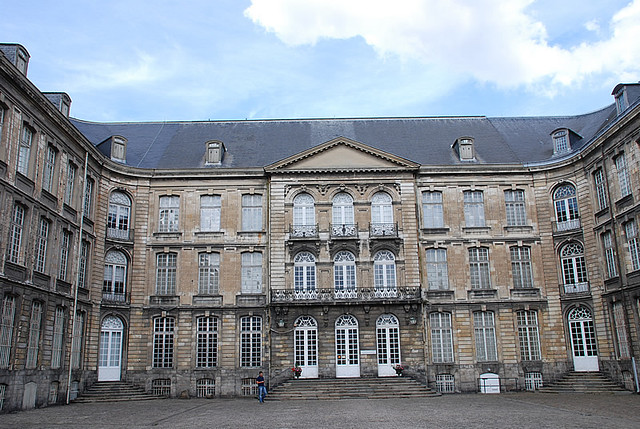
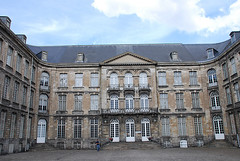
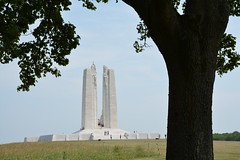



![Vallée de la Scarpe [ Explore ]](https://live.staticflickr.com/7050/6943353143_14f9dea0d9_m.jpg)

